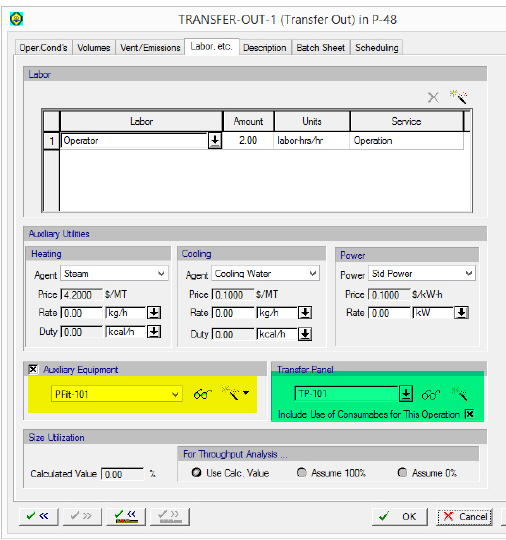

This dialog tab is common to all operations’ I/O simulation data; it allows you to set the following:
•Labor Amount...
This is the labor coefficient for the operation. It specifies how many operator hours per operation hour are required. Essentially, this coefficient allows you to specify how many operators need to be occupied while this operation is being carried out. Fractional values are meaningful in the sense that perhaps an operator needs to spend only a fraction of his/her time during the progress of this operation (while he/she is supervising the execution of another operation).
•Auxiliary Equipment...
For most operations, only the yellow highlighted choice is available. Here you can engage with this operation ANY auxiliary equipment (of any type, pre-built or user-defined). The assignment is not in any way connected to the operation’s performance (throughput, power consumption, etc.) so the equipment picked in this option will NOT be sized by the operation and it will not be checked for capacity violations (if it’s in rating mode). The only consequence of the assignment is:
a) for SuperPro to keep track of its engagements in time, and if there’s a sharing violation it will be reported, and
b) if there are any consumables associated with the operation of this equipment, they will add to the operating cost of the process.
For some operations that involve actual material transfer (like the ‘Transfer Out’ shown in the picture above), a transfer panel can also be assigned on this tab (the green highlighted area in the picture above). The assignment will draw from the operation’s performance characteristics (mainly throughput) to size the transfer panel, or if the panel is in rating mode, it will check to make sure the panel has enough throughput to support the needs of the operations that may (simultaneously) be asking for its services.
• Auxiliary Utilities...
Auxiliary utilities (Heating/Cooling/Power) are amounts of utilities that are not normally being calculated as part of the simulation model of the operation. If significant amounts are being consumed, then you should specify their rate of consumption in this dialog. Note that rates are required as amounts / h where h refers to operation hour (i.e. time during which the operation is being carried out). When you specify an auxiliary heating, cooling, or power requirement for a specific operation, the resulting values are not used in heat balances. The values are only used in calculating the operating cost of the equipment associated with that unit procedure and for adding to the consumption levels of that resource. The agents of the auxiliary utility are selected from the heat transfer agents databank. If the desired agent is not defined, you can add it to the heat transfer agents databank.
• Size Utilization for Throughput Analysis...
Specify how the equipment capacity utilization factor is to be calculated in the Throughput Analysis Report. The equipment capacity utilization factor indicates how much of the available equipment capacity (e.g. volume) this operation is using up. This factor is employed heavily in the throughput analysis performed by SuperPro Designer. SuperPro Designer has its own logic for computing these factors for every type of operation. The user may allow the computed value to be used in the throughput analysis, or he/she may overwrite the computed value to either extreme: 100% (thus increasing the likelihood that the program will consider this operation and its equipment as potential bottlenecking candidates) or 0% (thus removing this equipment from the list of potential bottlenecking candidates). For more details, see Debottlenecking.